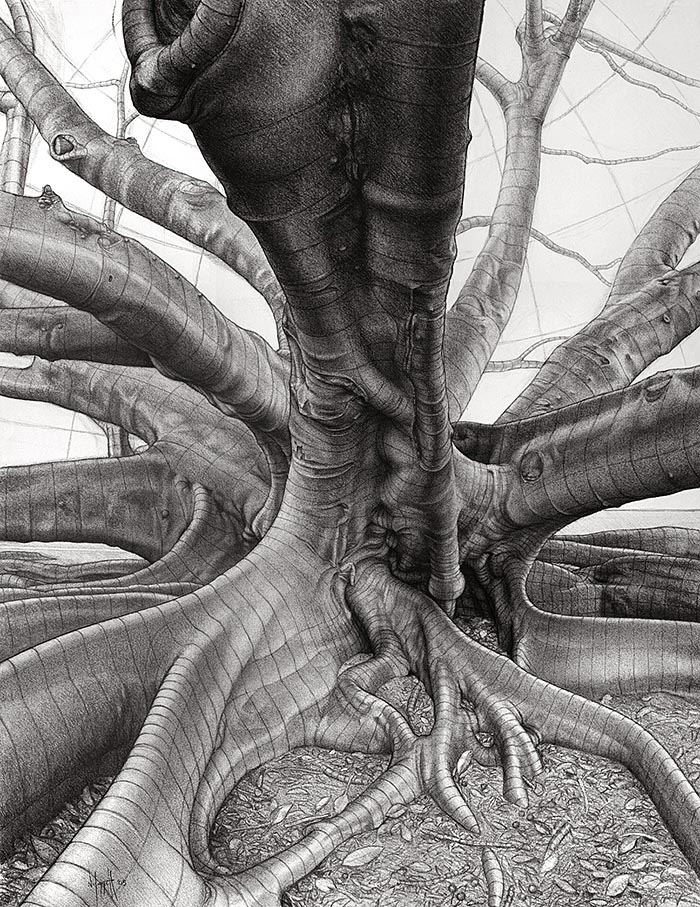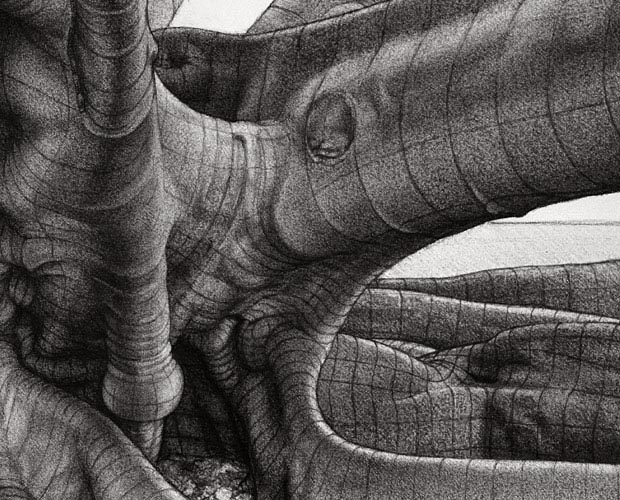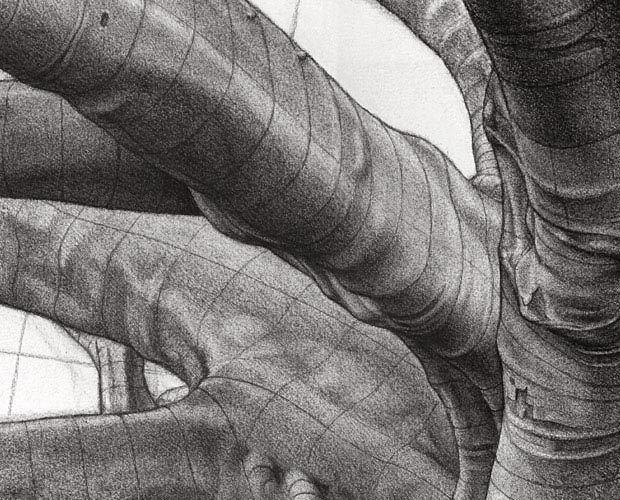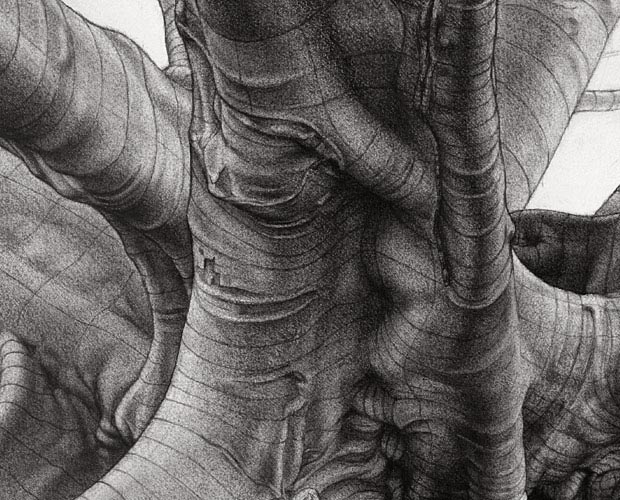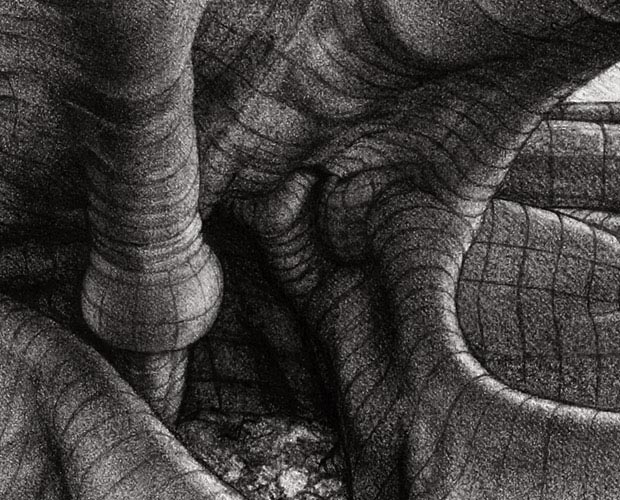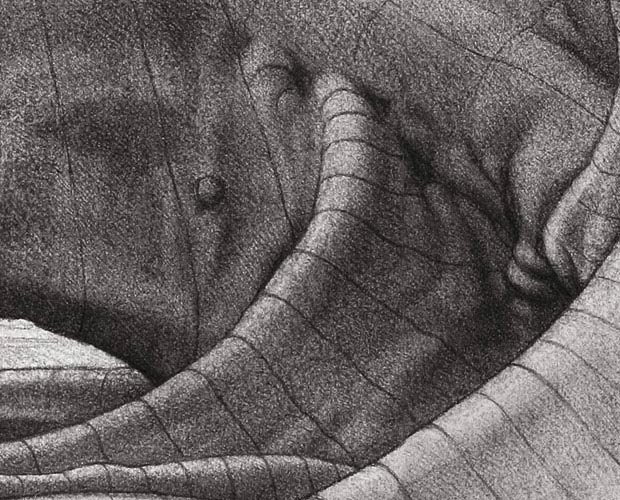58 cm (w) x 76 cm (h), charcoal on cream acid-free drawing paper.
Date produced: March - May 2005
I produced this drawing entirely on-site (“en plein air”) in the Adelaide Park Lands. It was produced as part of an art project called “Microcosm”, where I spent two years (2005 and 2006) working on pieces directly from one Moreton Bay Fig tree growing in the Adelaide Park Lands.
The drawing’s view is a very wide-angle view of what I saw. I was sitting very close to the tree, with one leg of my portable easel not far from the ground shown at the bottom of the drawing. Working with such a wide angle view directly from such a huge subject was quite a challenge in itself.
The ideal light for producing this drawing was when it was overcast, but that didn’t happen very often, and when it did, it put the drawing at some risk of damage should it rain suddenly (it did get some fine rain drops on it once). Most of the sessions were carried out in fine sunny conditions, using the different times of the day for drawing different parts of the subject (when they were suitably shaded).
This is the largest, most finished charcoal drawing I have ever produced, and I learnt many things about using the medium. I was keen to include my linear expressions of form, orientation, and flow, (drawing imagined grids over the various forms) over a layer of highly developed tone. I found that a tonal depiction on its own didn’t express the forms strongly or accurately enough.
I am happy with the accuracy and subtlety achieved in this depiction of real organic forms of the tree. The subject is a magnificent tree, and working under it day after day was a real privilege.
I modified the tonal relationships of the boughs to give a better sense of space - I made the close bough a little darker to bring it forward, and I lightened the more distant boughs a little to push them further back (behind more air). Doing this helped ‘open’ the space in the drawing, to better match the space as it was experienced.
While doing the early stage of this drawing the weather was hot (in early February) and I was getting a strong smell of rotting flesh. I quickly realised that the smell was coming from a dead possum, that was lying mostly under leaves directly in front of me under the spherical bulb that can be seen in the drawing. Even though the possum was dead, it gave me the impression that it had been trying to feel protected, because it was in a curled-up sleeping position close to the tree (as if trying to get as much protection from the tree as possible). After getting the drawing to a reasonable stage, I left it for a few weeks and worked on other drawings until the smell had subsided.
The remaining development of the drawing required another 50-70 (?) half-day sessions. Most sections of the drawing needed to be finely developed two or three times, to get the depiction of form, and overall integrity I wanted. I spent a considerable slice of the time required to complete each section of the drawing maintaining the point of my charcoal pencil(s) as I worked (using several pencil sharpeners and a sanding block).
When observing the tree, I was constantly seeing an underlying structure made from discrete ‘tubes’ of varying diameters, covered with a flexible form-hugging skin. The reality is that the skin of the tree is quite hard, and not very flexible. Also, if one were to cut through a section of the buttress roots, or one of the boughs, one wouldn’t see the cross section as being made up of discrete ‘tubes’. Where does that appearance come from then?
When I started the drawing, there were many thick sections of old spider webs covering the underside of the main overhanging bough in the drawing. I wasn’t sure how I was going to tackle those in my drawing. In the end, I didn’t need to worry about them. As the weather got cooler and the breezes started to come through with frequent rain, most of those webs peeled away from the tree (after having collected many stray pieces of leaves and grass), leaving an excellent view of the underlying forms. I was quite surprised watching the old webs peel away from the tree over the course of about a week, but I was also very pleased. I now had a very clear view of the details that had been obscured somewhat by the webs, and it felt as if that section of the tree had been ‘freshened’.
The drawing was transported to and from the site, without protection - I normally protect my drawings during transportation with cover sheets of paper, but I found that the charcoal was too easily smudged and damaged even by putting a protective sheet of large tissue paper over it. To carry the drawing without a protective cover sheet, I needed to glue a piece of wood on the back of the drawing board to act as a handle, and I would hold the drawing board in either my left or right hand with the back of the drawing board facing away from me and the unprotected drawing facing inwards. Obviously, I would need to make sure that that drawing did not touch any part of me as I walked, or that would damage the drawing. As I walked the drawing to the site, I would also need to make sure that the drawing itself was not being damaged by being in direct sunlight. I needed to work out for each angle of my walk to and from the tree, which side of my body I needed to carry the drawing to avoid having direct sunlight shine on my drawing. I would need to carry all of the other equipment required (including easel, folding chair, drawing equipment, water, etc.) using my other hand. Any reasonable wind could make carrying the drawing tricky as well, because the drawing on the drawing board had a considerable area and would always get buffeted in the wind. All of these aspects required considerable management and discipline, and were required for every moment during every trip to the tree from my home, or to my home from the tree, or every trip I needed to make to the toilet while I was trying to work at the tree. I am confident that not many other people would be able to maintain such discipline or have the skills to do such a drawing on-site.
“Inner Strength” is a title my wife suggested, and is intended to refer to several aspects, relating to the subject, the drawing and my approach to the drawing. | 

